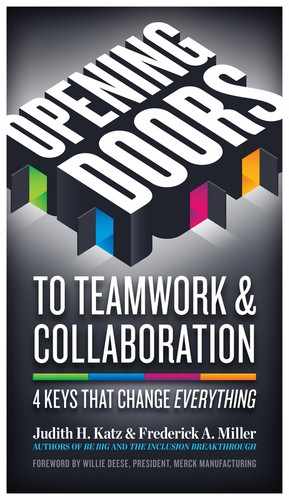Opening the Door to ….. TRUST
Key #1: Lean into Discomfort

Lean into Discomfort
![]() TAKE RISKS: experiment with new behaviors and actions.
TAKE RISKS: experiment with new behaviors and actions.
![]() SPEAK UP: address issues.
SPEAK UP: address issues.
Everything new feels uncomfortable at first, which is why discomfort is a prerequisite for learning, growth, and change.

For most people, trusting others—and truly joining them—is challenging, and that can be uncomfortable.
Discomfort does
not always
mean stop and
run for cover.
Some things that make me uncomfortable are just unsafe situations and not great ideas to pursue. The discomfort I may feel when someone suggests bungee jumping into a volcano, for example, is a useful warning to heed.
But what about when I feel discomfort interacting with new team members because I am unsure of what they bring to the team or what working with them will be like? Avoiding those interactions is not the best course of action.
The same goes for the discomfort I might feel when I need to work with someone in another department or whose language is different, or when I need to present new ideas in front of a room of leaders.
If I discover the sky is falling, then yes, I should probably run. But most of the time, discomfort is just a signal that I need to pay attention to something new and different. That includes opportunities to make a contribution. And on some occasions, it is a signal not just that something is different, but that I have an opportunity to make a difference.
Discomfort is a signal that alerts us to possible opportunities for learning, growth, and change.
Discomfort means:
PAY ATTENTION!
Watch out for
Change, Opportunity,
Learning, Growth
What does discomfort have to do with trust?
When we talk to people in organizations about how to Lean into Discomfort as the key to opening the Door to Trust, we often hear the following:
“I am comfortable with the people I trust, and I only trust people with whom I am comfortable.”
Trusting others—especially people outside our closest circle of family, friends, colleagues, or team members—is often uncomfortable. And most of the time we avoid discomfort as a matter of course.
But today’s organizations don’t have the time to wait for people to develop the comfort levels usually required to build trust, so Lean into Discomfort needs to be an unwritten part of our job descriptions.
Trust is fundamental for our most productive interactions. Without trust, our interactions are flawed at best, destructive at worst, and uncomfortable always. When you Lean into Discomfort, you make it possible to open the door to an environment in which trust can grow quickly.
We avoid situations
that make us feel
uncomfortable. If THIS
way feels uncomfortable,
we tend to go THAT way.
When we open the door and trust…
![]() we are willing to give each other the benefit of the doubt.
we are willing to give each other the benefit of the doubt.
![]() we expect to connect and gain something from our interaction.
we expect to connect and gain something from our interaction.
![]() we listen more attentively and appreciatively to one another.
we listen more attentively and appreciatively to one another.
![]() we look for the value in what our colleagues say and build on that.
we look for the value in what our colleagues say and build on that.
![]() we show we are willing to act in spite of our discomfort, trusting our partners to have our backs.
we show we are willing to act in spite of our discomfort, trusting our partners to have our backs.
![]() we let our partners know we have their backs and that they can trust us.
we let our partners know we have their backs and that they can trust us.
![]() team members are more likely to extend trust to us.
team members are more likely to extend trust to us.
![]() we support and encourage our team members to Be BIG, step out, and Lean into Discomfort as well.
we support and encourage our team members to Be BIG, step out, and Lean into Discomfort as well.
![]() we are more willing to join together, share information, and get to root causes of difficult issues more quickly.
we are more willing to join together, share information, and get to root causes of difficult issues more quickly.
![]() we know we will get better as we work together and learn from one another.
we know we will get better as we work together and learn from one another.
![]() we are more likely to act like a team.
we are more likely to act like a team.
![]() we collaborate more effectively.
we collaborate more effectively.
![]() we are open and willing to be innovative.
we are open and willing to be innovative.

When you consider
the alternative,
if you could
choose trust, why
wouldn’t you?
Change Requires Us to Lean into Discomfort
Change can be hard. But in today’s global marketplace, the ability to learn and adapt to a constantly changing environment is a critical skill—for each of us as individuals and for our organizations as well. To respond to the hastening pace of technological and social change, we need to be able to step outside our comfort zones and change the way we work individually and collectively, in established work groups, across departments, as part of ad hoc teams, and virtually across the globe. Few of us can afford not to change.
Given a choice between feeling comfortable and feeling uncomfortable, I will choose comfort most of the time. But should I make that choice?
Staying in our comfort zones may feel familiar, safe, and secure, but it is very hard to be open to anything new.

I can’t keep doing things
the same old way and
expect the results to
ever be any different.
There’s another reason each of us often resists change:
“If something I have been comfortable doing has been working well enough to produce success, it doesn’t make sense to change it. That is just common sense: don’t mess with success.”
But increasingly, that bit of common sense is making it harder for individuals to adapt to changing conditions. And conditions keep changing rapidly, both in our organizations and in the world. When what worked yesterday stops working today, we probably need to try something new.
So what’s stopping us from wanting to Lean into Discomfort?
“I tried to raise an issue once. I learned my lesson.
It is not safe to be open and honest here.”
“I’m busy right now. I’ll get around to
it when things slow down.”
“It feels awkward. I don’t want to
make a fool of myself.”
![]() When is the right time to Lean into Discomfort? The answer: usually as soon as we notice there are issues and begin to feel a sense of discomfort that something is not quite right. That is the time to say: “I am going to be courageous, Be BIG, and Lean into Discomfort to address this issue now.”
When is the right time to Lean into Discomfort? The answer: usually as soon as we notice there are issues and begin to feel a sense of discomfort that something is not quite right. That is the time to say: “I am going to be courageous, Be BIG, and Lean into Discomfort to address this issue now.”
![]() Often when something feels risky we find ways to put it off, hoping the issue will just go away. But if now is not the right time, when is? If we put it off, aren’t we just trading one set of problems for another? If addressing the issue this way will create greater trust, eliminate waste, or prevent bigger problems down the road, isn’t this exactly the right time to lean in?
Often when something feels risky we find ways to put it off, hoping the issue will just go away. But if now is not the right time, when is? If we put it off, aren’t we just trading one set of problems for another? If addressing the issue this way will create greater trust, eliminate waste, or prevent bigger problems down the road, isn’t this exactly the right time to lean in?
![]() Many new and different behaviors start out feeling awkward and abnormal. So we need to practice leaning in so it will become less and less awkward. And pretty soon, leaning in will become the new normal.
Many new and different behaviors start out feeling awkward and abnormal. So we need to practice leaning in so it will become less and less awkward. And pretty soon, leaning in will become the new normal.

When we Lean into Discomfort,
it enables greater
collaboration as we trust
each other to say the things
that need to be honestly
said without fear of being
judged or second-guessed.
The cost of not creating trust
I may be reluctant to Lean into Discomfort and trust others because I have been hurt before. Or because I fear others will take advantage of me. Or because I believe they must earn my trust.
But the cost of not trusting is high. Without trust, we …
![]() waste our time and energy in judging and feeling judged.
waste our time and energy in judging and feeling judged.
![]() are more guarded toward each other.
are more guarded toward each other.
![]() don’t easily build on each other’s ideas.
don’t easily build on each other’s ideas.
![]() have more difficulty supporting each other’s growth.
have more difficulty supporting each other’s growth.
![]() speak only when we are certain.
speak only when we are certain.
![]() close the door to opportunities for more productivity and efficiency, and also for more creativity and joy.
close the door to opportunities for more productivity and efficiency, and also for more creativity and joy.

Creating
safety is not
a passive act.
So how do we make it safer to Lean in ?
If we only did what was safe, we would never have learned to ride a bicycle. Sure, we might have skinned our knees and fallen a few times, but that didn’t mean we stopped trying. As toddlers, if we had stopped trying to stand and walk because of how often we fell, we would still be crawling. Just about every new skill is awkward and possibly embarrassing in the beginning—but that should not stop us from learning and growing.
To help create safety (for ourselves and others), we need to …
![]() Share with others what we need to feel safe.
Share with others what we need to feel safe.
![]() Lean into Discomfort and speak up when we don’t feel safe.
Lean into Discomfort and speak up when we don’t feel safe.
![]() ask others what they need to feel safe so they can Lean in with us.
ask others what they need to feel safe so they can Lean in with us.
![]() reach out to extend safety to others—even if they differ from us.
reach out to extend safety to others—even if they differ from us.
![]() be brave and at times be willing to be first.
be brave and at times be willing to be first.
Creating safety does not mean eliminating risk
Creating the safety needed to Lean in does not mean creating a risk-averse environment, or even a risk-free environment. It means fostering an environment that respects and acknowledges the differing approaches and experiences of all team members, and what each of us needs to feel safe so we can do our best work. It means putting as much (or more) effort into psychological and emotional safety as some organizations do for physical safety.
The goal is an environment in which we each feel psychologically and emotionally safe enough to trust that others have our back rather than stabbing us in the back—an environment in which we can speak up without fear of retribution, an environment where we trust each other. An environment where we all can succeed.

One way I encourage
others to Lean into
Discomfort:
I go first!
When we Lean into Discomfort, we …
![]() are more willing to share our ideas.
are more willing to share our ideas.
![]() are more willing to try new techniques and learn new skills.
are more willing to try new techniques and learn new skills.
![]() are more likely to lend a hand to the person in the next cubicle.
are more likely to lend a hand to the person in the next cubicle.
![]() are more welcoming to colleagues we meet in the elevator or walk by in the hallways.
are more welcoming to colleagues we meet in the elevator or walk by in the hallways.
![]() are more likely to say hello to colleagues who look familiar but whose names we don’t know.
are more likely to say hello to colleagues who look familiar but whose names we don’t know.
![]() don’t take crazy or unwarranted risks, but are willing to take worthwhile risks.
don’t take crazy or unwarranted risks, but are willing to take worthwhile risks.
![]() are willing to talk about the elephant in the room—even if others are not willing to address it or admit that it is there.
are willing to talk about the elephant in the room—even if others are not willing to address it or admit that it is there.
![]() know that if things don’t work out, at least we did our part.
know that if things don’t work out, at least we did our part.

The cost of creating
an emotionally unsafe
environment is high. So much
goes unspoken, and so much
talent is left behind …
Delayed Gratification
After noticing how new team members were often excluded from informal planning sessions and lunch meetings, Mike decided to Lean into Discomfort by raising the issue in the next staff meeting. He prefaced his remarks with “I’m going to Lean into Discomfort to raise an issue that is keeping us from using all our resources as well as we could.”
The room was quiet after he spoke. The team leader responded by saying, “We always try to make the best use of everyone’s skills. Does anyone have a response to Mike’s remarks?”
But no one said a word, and the leader went on to the next item on the agenda. Mike was worried that he had wasted his breath and damaged his standing with the team leader and the team.
After all the agenda items had been discussed, the team leader returned to the issue Mike raised. “Earlier in our meeting, Mike suggested that, as a team, we are not doing a good job of using all the resources of our team. And when I asked whether anyone had a response to Mike’s observation, I heard no responses.”
The leader looked around the conference table. The room was full of uncomfortable people.
“I learned three things from Mike’s comments, and from the team’s lack of response” said the leader. “First, I learned that as a leader, I am not doing a good enough job of encouraging and requiring all of us to bring our voices into meetings and planning sessions. Second, I learned that our newer staff members are not feeling safe enough or invited enough to fully contribute. And third, I learned that the rest of you are not feeling safe enough or supportive enough to respond to comments like Mike’s, whether you agree or disagree.”
The leader was quiet. Slowly, the team members began to speak up, sharing their ideas about what was blocking them from speaking up and ways to better utilize team members’ experiences.
The resulting surge in energy and engagement started with one person Leaning into Discomfort, and it changed everything for Mike and the team.

Do YOU feel
safe enough to
STEP OUT?
And the Door to Trust Starts to Open …
That’s why the first Key to changing Everything is to Lean into Discomfort.
“I am going to Lean into Discomfort and …”
One of the best ways to model how to Lean into Discomfort is by letting others know when I am doing it.
By establishing a common language and using those actual words, I signal to others that I am reaching out and extending trust, willing to be vulnerable, and extending an invitation to reciprocate.
When I Lean into Discomfort, I encourage others to reach beyond their comfort zones and join me in creating a more engaging and productive workplace environment.
When I say, “I am going to Lean into Discomfort,” it is an invitation for others to Listen as Allies and to find ways to join me. (See chapter 2, coming up in just a few pages!)
It is a simple equation: as I lean in, others become more willing to lean in. As we all lean in together, greater trust is created, greater synergies are created, and greater teamwork and collaboration become possible.
New Route to Success
As we were beginning work with his company, a hardworking senior leader described some of the ways he tried to be efficient with his time. One way was by taking a shortcut from the parking garage to his desk. It enabled him to avoid the delays and distractions of having unscheduled conversations with people along the way. As an introvert, this also allowed him to avoid having to talk and interact with lots of people on the way to his office, which to him seemed like a good idea.
As we discussed the importance of workplace interactions, he realized that he had lost connection with the people in his organization. He decided to Lean into Discomfort by taking a new route that would bring him into contact with his team members rather than avoid them.
The first week or so, the route took a long time as he said hello to people and began to ask them questions about their work and their lives. Some had a lot to say, including things that were uncomfortable for him to hear. Some people had stored up a lot of issues they wanted to discuss with him if they ever got the opportunity, and believing this might be their only opportunity, they told him all that they had stored up.
But after those first few weeks, as his practice of walking the halls in the morning continued, the exchanges became faster and friendlier. People learned to trust that he would be back and that he would follow up on issues they raised. He learned a great deal about issues that impacted his ability to lead and manage the organization, and he was able to assist others in their ability to get things done more quickly as well.
The new route started with Leaning into Discomfort, but it became the leader’s New Normal.
Oh, Yes I Do!
In a high-volume manufacturing plant, a work team was meeting to address some critical quality and productivity processes. One of the team members, Martha, said to the team and the leader, “I need to Lean into Discomfort right now …” and proceeded to raise some challenging issues that the team members knew about but had been avoiding speaking about directly.
The team leader’s response was, “You don’t need to say that! It is safe to raise any issue here.”
But Martha replied, “Oh, yes I do. I need to say ‘I am going to Lean into Discomfort’ because those words help me be brave.”
Martha went on to describe the issue, and the team had a very productive discussion about some of the things that were blocking their effectiveness and ability to deliver on time. After the meeting, the team leader thanked Martha for leaning in, and thanked the team for the great conversation.
Martha’s willingness to Lean into Discomfort was the key to greater productivity for the team.
It took one person to Lean to open that door.

When I LEAN in, I make it
safer for others to LEAN
in TOO. Which, in turn,
opens the door to greater
teamwork and collaboration.
Checklist for Leaning into Discomfort
![]() Use the language “I am going to Lean into Discomfort” to signal you are moving out of your comfort zone and inviting others to join you.
Use the language “I am going to Lean into Discomfort” to signal you are moving out of your comfort zone and inviting others to join you.
![]() Lean in by taking small steps—sitting up front when you normally sit in the back, speaking up when you ordinarily would be silent.
Lean in by taking small steps—sitting up front when you normally sit in the back, speaking up when you ordinarily would be silent.
![]() Discuss what you need in order to feel safe to speak up.
Discuss what you need in order to feel safe to speak up.
![]() Invite others to discuss what they need to feel safe to speak up.
Invite others to discuss what they need to feel safe to speak up.
![]() Acknowledge and support other team members when they Lean into Discomfort.
Acknowledge and support other team members when they Lean into Discomfort.




